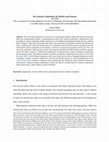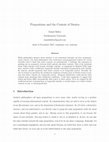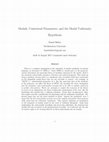Publications by Daniel Skibra

Synthese, 2022
A thorny question surrounding the meaning of ought concerns a felt distinction between deontic us... more A thorny question surrounding the meaning of ought concerns a felt distinction between deontic uses of ought that seem to evaluate a state of affairs versus those that seem to describe a requirement or obligation to perform an action, as in (A) and (B), respectively. (A) There ought not be childhood death and disease. (B) You ought to keep that promise. Various accounts have been offered to explain the contrast between "agentive" and "non-agentive" ought sentences. One such account is the Agency-in-the-Prejacent theory ("AIP"), which traces the difference to a particular kind of ambiguity in the prejacent. This theory has been criticized as linguistically unviable. Indeed, I level a few novel complaints against AIP myself in the present paper. But AIP has a kernel of genuine insight which allows us to explain the contrast-that the distinction between agentive and non-agentive ought sentences owes in part to the way natural language encodes information about agency. I develop this idea into a novel account that, like AIP, traces the contrast to an ambiguity in the complement of the modal. However, according to the view I propose, the Coercion View, a linguistically-motivated coercion operation produces the necessary grammatical conditions for agentive ought, which in turn allow a kind of variadic function operator in the style of (in: Recanati, Literal Meaning. Cambridge University Press, 2004) to produce the semantic effect we see on display in agentive readings of ought. Having explained the mechanism by which we get this structure, I show that it corroborates some of the central intuitions underwriting agentive ought. I submit that the Coercion View offers an explanation of agentive ought to take at least as seriously as any of its competitors.

Review of Philosophy and Psychology, 2020
This is a pre-print of an article published in the Review of Philosophy and Psychology. The final... more This is a pre-print of an article published in the Review of Philosophy and Psychology. The final authenticated version is available online at: https://doi.org/10.1007/s13164-020-00502-9
Abstract: The view that dominates the literature on intentional attitudes holds that beliefs and desires both have propositional content. A commitment to what I call "content uniformity" underlies this view. According to content uniformity, beliefs and desires are but different psychological modes having a uniform kind of content. Prima facie, the modes don't place any constraint on the kinds of content the attitude can have. I challenge this consensus by pointing out an asymmetry between belief contents and desire contents which shows content uniformity to be mistaken. I do this by revisiting the arguments of Richard 1981, and show that arguments which purport to show the temporal specificity of belief contents yield the opposite results for desire contents. I defend this preliminary conclusion from various strategies to neutralize the asymmetry claim. My defense provides occasions to respond to objections by Brogaard (2012) and Recanati (2007) to the Richard argument, and to get clearer on the role of temporal adjuncts in desire ascriptions. Finally, I consider whether the construal of attitude content as centered propositions (as in Lewis 1979) can be invoked to vindicate content uniformity. My conclusion is that while the framework itself doesn't vindicate content uniformity, it could, but only if it availed itself of a further, substantive thesis about desire, which itself is in need of defense.
NELS 49: Proceedings of the Forty-Ninth Annual Meeting of the North East Linguistic Society, 2019
and from the brief but helpful comments of three referees for NELS. An anonymous referee once poi... more and from the brief but helpful comments of three referees for NELS. An anonymous referee once pointed something very similar to the EIP out to me in a referee report. Since those comments provided the occasion for the present paper, I thank this anonymous referee, whoever they are.
Drafts by Daniel Skibra

[Note: This draft has been superseded by my "On Content Uniformity for Beliefs and Desires", fort... more [Note: This draft has been superseded by my "On Content Uniformity for Beliefs and Desires", forthcoming in the Review of Philosophy & Psychology; https://doi.org/10.1007/s13164-020-00502-9 ] While philosophers disagree about whether or not intentional attitudes can have nonpropositional content, even those philosophers who countenance non-propositional content for certain attitudes tend to think that desire contents are propositional. I challenge this consensus by pointing out an asymmetry between belief contents and desire contents. First of all, intuitions about belief contents tend towards eternalist contents, as arguments by Richard [1981] make clear, and fit in with a traditional, temporally absolute conception of propositions more broadly. By contrast, parallel arguments show desire contents to be temporally neutral. Secondly, the role of contents as specifying the satisfaction conditions of desires gives us further reason to suppose that desire contents are temporally neutral. Temporal absoluteness would prevent these contents from specifying their satisfaction conditions. I take these arguments to suggest that beliefs and desires differ systematically with respect to their content. If we are tempted by the traditional picture of propositions as temporally absolute, it would require us to think of desire contents as non-or sub-propositional.

There is a common assumption in the semantics of modal auxiliaries in natural language; in uttera... more There is a common assumption in the semantics of modal auxiliaries in natural language; in utterances of MOD φ, where MOD is a modal and φ is the prejacent, context determines the particular flavor of modality expressed by the modal. Such is the standard contextualist semantics of Kratzer and related proposals. This winds up being a problem, because there is a significant class of modals which have constraints on the admissible modal flavor that are not traceable to context. For example, in MUST φ, subsentential properties of φ, like the aspectual class of the predicate in the prejacent, can affect the flavor of MUST. By encoding the above assumption into the semantics, such contextualist accounts fail to be able to explain, much less to predict, this pattern. Worse yet, attempts to exploit the resources of the theory in service of an explanation run afoul of important commitments of the view, like the hypothesis that modals have a uniform semantics. Given these circumstances, these data might seem like a justification for dispensing with the uniformity hypothesis. The present paper lays out the above problem in detail. Against the pessimistic view, I argue that the the contextualist account can in fact explain and predict these patterns while preserving the uniformity hypothesis. This requires adopting an amendment to the semantics of modals based on the work of Valentine Hacquard. Aside from maintaining the contextualist paradigm and preserving uniformity, the proposal also clarifies the role of context in the interpretation of modals. As it will turn out, the role of context ought to be circumscribed in its flavor-determining role for modals.
Papers by Daniel Skibra

The following paradigm, most closely associated with the work of Angelika Kratzer, dominates the ... more The following paradigm, most closely associated with the work of Angelika Kratzer, dominates the literature on the semantics of modals: MUST is a universal quantifier over a contextually determined set of worlds, where \(\ulcorner \)MUST \(\phi \urcorner \) is true just in case ϕ holds in each of these worlds. The quantifier is restricted via the setting of values for various contextual parameters relative to which the modal is interpreted. Notwithstanding its important virtues, I aim to show that the standard way of carrying out the paradigm overgenerates in a pretty severe way with prejacents with eventive predicates. The argument of this chapter concerns this overgeneration problem and can be broken down into two sub-claims: CLAIM 1: If context is responsible for setting the values of the parameters relative to which modals are semantically evaluated, then we can’t account for this common pattern in the interpretation of modal auxiliaries. CLAIM 2: These data provide independent ...











Uploads
Publications by Daniel Skibra
Abstract: The view that dominates the literature on intentional attitudes holds that beliefs and desires both have propositional content. A commitment to what I call "content uniformity" underlies this view. According to content uniformity, beliefs and desires are but different psychological modes having a uniform kind of content. Prima facie, the modes don't place any constraint on the kinds of content the attitude can have. I challenge this consensus by pointing out an asymmetry between belief contents and desire contents which shows content uniformity to be mistaken. I do this by revisiting the arguments of Richard 1981, and show that arguments which purport to show the temporal specificity of belief contents yield the opposite results for desire contents. I defend this preliminary conclusion from various strategies to neutralize the asymmetry claim. My defense provides occasions to respond to objections by Brogaard (2012) and Recanati (2007) to the Richard argument, and to get clearer on the role of temporal adjuncts in desire ascriptions. Finally, I consider whether the construal of attitude content as centered propositions (as in Lewis 1979) can be invoked to vindicate content uniformity. My conclusion is that while the framework itself doesn't vindicate content uniformity, it could, but only if it availed itself of a further, substantive thesis about desire, which itself is in need of defense.
Drafts by Daniel Skibra
Papers by Daniel Skibra
Abstract: The view that dominates the literature on intentional attitudes holds that beliefs and desires both have propositional content. A commitment to what I call "content uniformity" underlies this view. According to content uniformity, beliefs and desires are but different psychological modes having a uniform kind of content. Prima facie, the modes don't place any constraint on the kinds of content the attitude can have. I challenge this consensus by pointing out an asymmetry between belief contents and desire contents which shows content uniformity to be mistaken. I do this by revisiting the arguments of Richard 1981, and show that arguments which purport to show the temporal specificity of belief contents yield the opposite results for desire contents. I defend this preliminary conclusion from various strategies to neutralize the asymmetry claim. My defense provides occasions to respond to objections by Brogaard (2012) and Recanati (2007) to the Richard argument, and to get clearer on the role of temporal adjuncts in desire ascriptions. Finally, I consider whether the construal of attitude content as centered propositions (as in Lewis 1979) can be invoked to vindicate content uniformity. My conclusion is that while the framework itself doesn't vindicate content uniformity, it could, but only if it availed itself of a further, substantive thesis about desire, which itself is in need of defense.